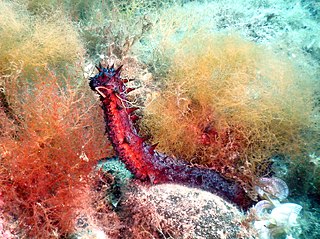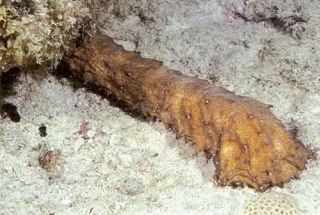
Sea cucumbers are echinoderms from the class Holothuroidea. They are marine animals with a leathery skin and an elongated body containing a single, branched gonad. They are found on the sea floor worldwide. The number of known holothurian species worldwide is about 1,786, with the greatest number being in the Asia-Pacific region. Many of these are gathered for human consumption and some species are cultivated in aquaculture systems. The harvested product is variously referred to as trepang, namako, bêche-de-mer, or balate. Sea cucumbers serve a useful role in the marine ecosystem as they help recycle nutrients, breaking down detritus and other organic matter, after which bacteria can continue the decomposition process.

Holothuria atra, commonly known as the black sea cucumber or lollyfish, is a species of marine invertebrate in the family Holothuriidae. It was placed in the subgenus Halodeima by Pearson in 1914, making its full scientific name Holothuria (Halodeima) atra. It is the type species of the subgenus.

Holothuria mexicana, the donkey dung sea cucumber, is commonly found in the Caribbean and the Azores. It is a commercially important aspidochirote sea cucumber that can reach a total length of 50 cm (20 in).

Holothuria forskali, the black sea cucumber or cotton-spinner is a species of sea cucumber in the family Holothuriidae. It is found at shallow depths in the eastern Atlantic Ocean and the Mediterranean Sea. It was placed in the subgenus Panningothuria by Rowe in 1969 and is the type taxon of the subgenus.

Holothuria scabra, or sandfish, is a species of sea cucumber in the family Holothuriidae. It was placed in the subgenus Metriatyla by Rowe in 1969 and is the type species of the subgenus. Sandfish are harvested and processed into "beche-de-mer" and eaten in China and other Pacific coastal communities.

Holothuria tubulosa, the cotton-spinner or tubular sea cucumber, is a species of sea cucumber in the family Holothuriidae. It is the type species of the genus Holothuria and is placed in the subgenus Holothuria, making its full name Holothuria (Holothuria) tubulosa.

Holothuria thomasi, the tiger's tail, is a species of sea cucumber in the family Holothuriidae. Although it is the largest sea cucumber known in the western Atlantic Ocean, it is so well camouflaged that it was 1980 before it was first described. It is placed in the subgenus Thymiosycia making its full name Holothuria (Thymiosycia) thomasi.
Holothuria spinifera, the brown sandfish, is a species of sea cucumber in the family Holothuriidae. It is placed in the subgenus Theelothuria, making its full name Holothuria (Theelothuria) spinifera. In India it is known as cheena attai or raja attai. It lives in tropical regions of the west Indo-Pacific Ocean at depths ranging from 32 to 60 metres. It is fished commercially to produce beche-de-mer.

Holothuria parvula, the golden sea cucumber, is a species of echinoderm in the class Holothuroidea. It was first described by Emil Selenka in 1867 and has since been placed in the subgenus Platyperona, making its full scientific name Holothuria (Platyperona) parvula. It is found in shallow areas of the Caribbean Sea and Gulf of Mexico and is unusual among sea cucumbers in that it can reproduce by breaking in half.

Holothuria leucospilota, commonly known as the black sea cucumber or black tarzan, is a species of marine invertebrate in the family Holothuriidae. It is placed in the subgenus Mertensiothuria making its full scientific name Holothuria (Mertensiothuria) leucospilota. It is the type species of the subgenus and is found on the seabed in shallow water in the Indo-Pacific.

Holothuria edulis, commonly known as the edible sea cucumber or the pink and black sea cucumber, is a species of echinoderm in the family Holothuriidae. It was placed in the subgenus Halodeima by Pearson in 1914, making its full scientific name Holothuria (Halodeima) edulis. It is found in shallow water in the tropical Indo-Pacific Ocean.

Holothuria fuscocinerea, the ashy pink sea cucumber, is a species of sea cucumber in the family Holothuriidae. It is placed in the subgenus Stauropora, making its full name Holothuria (Stauropora) fuscocinerea. It is native to shallow water in the tropical and sub-tropical Indo-Pacific.

Holothuria fuscopunctata, the elephant trunkfish, is a species of sea cucumber in the family Holothuriidae native to shallow water in the tropical Indo-Pacific. It is placed in the subgenus Microthele, making its full name Holothuria (Microthele) fuscopunctata.
Holothuria grisea, the gray sea cucumber, is a mid-sized coastal species of sea cucumber found in shallow tropical waters of the Atlantic Ocean from Florida to Southern Brazil and West Africa. They have a variety in color and can range from red to more yellowish with brown markings. They are also a food source for local and international markets with the majority of harvesting taking place in Brazil. This species is currently not over-fished and is not endangered or threatened.

Holothuria hilla is a species of sea cucumber in the subgenus Mertensiothuria of the genus Holothuria. Some common names include the contractile sea cucumber, the sand sifting sea cucumber and the tigertail sea cucumber, and in Hawaii it is known as the light spotted sea cucumber. It is found in the Indo-Pacific region and the Red Sea.

Holothuria (Platyperona) difficilis is a species of sea cucumber in the family Holothuriidae. Holothuria comes from Latin but is originally taken from Greek. Its meaning is a plantlike animal whose origin is uncertain.

Holothuria (Roweothuria) poli, also known as the white spot cucumber, is a species of sea cucumber in the family Holothuridae and the subgenus Roweothuria. The species was first described by the Italian doctor and naturalist Stefano delle Chiaje in 1824. The species' range has been documented as being in the Mediterranean Sea, Red Sea, and the Bay of Biscay.
Holothuria (Cystipus) cubana is a species of sea cucumber in the family Holothuriidae. This species was first described by Ludwig in 1875.
Holothuria (Selenkothuria) glaberrima, also known as the brown rock sea cucumber, is a species of sea cucumber in the genus Holothuria, subgenus Selenkothuria. The cucumber is distributed in the Western Atlantic Ocean, the Caribbean Sea, and the Gulf of Mexico. The species is found at a depth of 0–42 meters.

Holothuria (Thymiosycia) impatiens, commonly known as the impatient sea cucumber or bottleneck sea cucumber, is a species of sea cucumber in the genus Holothuria, subgenus Thymiosycia.
Ramos-Miranda, J., del Río-Rodríguez, R., Flores-Hernández, D., Rojas-González, R. I., Gómez-Solano, M., Cu-Escamilla, A. D., Gómez-Criollo, F., Sosa-López, A., Torres-Rojas, Y. E., & Juárez-Camargo, P. (2017). Reproductive cycle of the sea cucumber Holothuria floridana in the littorals of Campeche, Mexico. Fisheries Science, 83(5), 699–714. https://doi.org/10.1007/s12562-017-1100-6

















